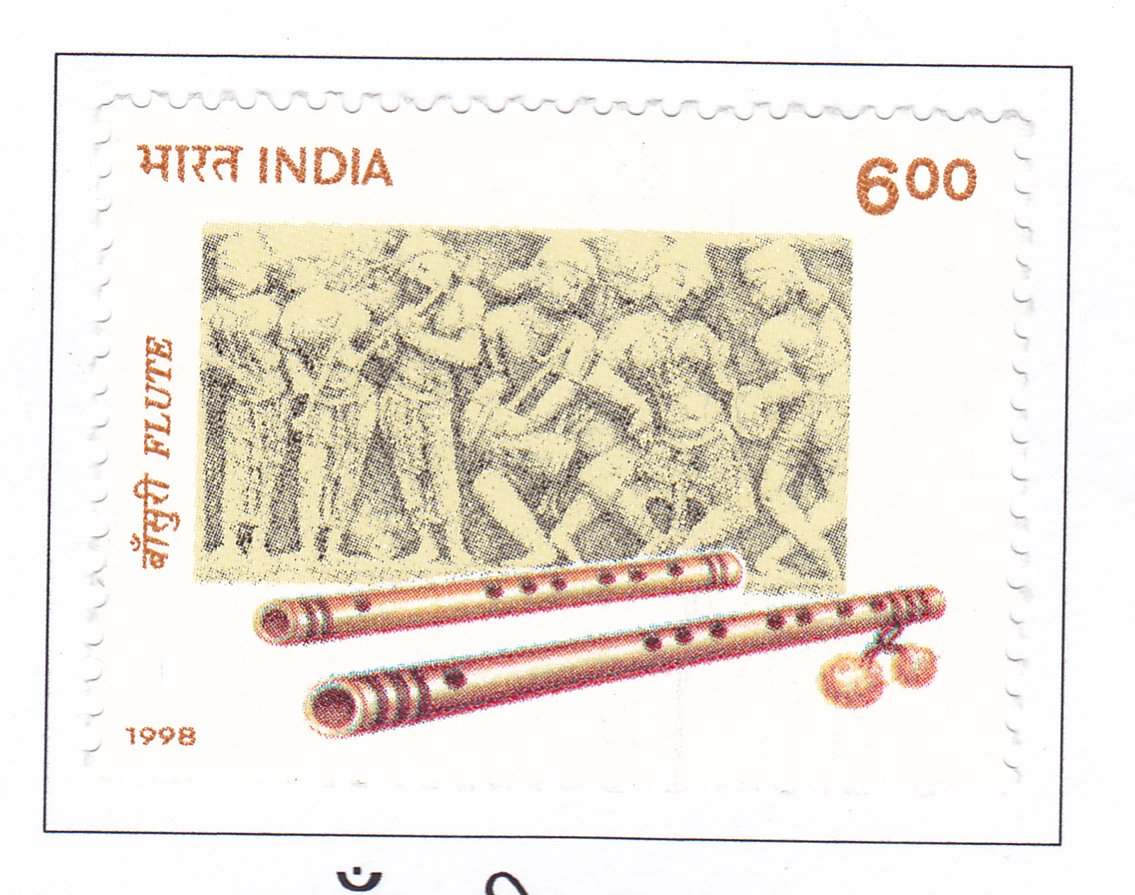Flute

Technical Data
| Stamp Set | Indian Musical Instruments |
|---|---|
| Date of Issue | December 29, 1998 |
| Denomination | Rs. 6 |
| Quantity | 700,000 |
| Perforation | comb 13½ x 13 |
| Printer | Security Printing Press, Nashik |
| Watermark | No Watermark |
| Colors | Multicolor |
| Catalog Codes |
Michel IN 1664 Stamp Number IN 1722 Yvert et Tellier IN 1429 Stanley Gibbons IN 1827 |
| Themes | Musical Instruments |
Table of Contents
Flute (Bansuri)
Overview:
The flute, commonly known in India as the Bansuri, is a prominent wind instrument with a rich history in Indian classical music. Its simple yet expressive design makes it a central element in both Carnatic and Hindustani music traditions.
Characteristics:
- Structure:
- Material: Traditionally, the Bansuri is made from bamboo, though it can also be crafted from metal or other materials. Bamboo is preferred for its natural resonance and ease of crafting.
- Shape: The Bansuri is a long, cylindrical tube with six to seven finger holes. It is usually between 30 to 40 centimeters in length.
- Finger Holes: The placement and number of finger holes determine the pitch and range of the flute. Each hole is carefully positioned to achieve specific notes.
- Playing Technique:
- Position: The Bansuri is played horizontally, with the player blowing air across the embouchure hole (the hole at the side) and using the fingers to cover the holes to produce different notes.
- Technique: The player uses techniques such as blowing with varying intensity and covering different combinations of finger holes to create melodies. Advanced techniques include ornamentations like slides, grace notes, and vibrato.
- Historical Significance:
- Origins: The Bansuri has ancient origins, with references found in Vedic texts and epics such as the Mahabharata and Ramayana. It is believed to be one of the oldest musical instruments in India.
- Role in Indian Music: In Indian classical music, the Bansuri is cherished for its ability to convey a range of emotions, from tranquility to joy. It is featured in both Hindustani (North Indian) and Carnatic (South Indian) music.
- Cultural Importance:
- Symbolism: The Bansuri is often associated with the divine and is famously linked with Lord Krishna, who is depicted playing the flute in Hindu mythology. The flute’s sound is considered to evoke the spiritual and the ethereal.
- Popular Music: Besides classical music, the Bansuri is also used in Indian folk music and Bollywood soundtracks, where it adds a melodic and enchanting quality to the music.
Commemorative Stamp Design:
- Visual Elements: The stamp featuring the Bansuri showcases the instrument in its traditional form, highlighting the intricate craftsmanship and the elegant simplicity of its design.
- Background: The background may include artistic depictions of classical Indian art or scenes reflecting the cultural significance of the flute, such as references to Lord Krishna playing the Bansuri.
Educational Value:
- Understanding Tradition: The stamp helps raise awareness about the Bansuri’s role in Indian classical music and its historical significance.
- Promoting Heritage: By commemorating the Bansuri, the stamp celebrates the instrument’s contribution to India’s musical heritage and encourages the appreciation of traditional music.
The Bansuri stamp is a tribute to this iconic wind instrument, emphasizing its timeless beauty and its important place in India’s cultural and musical history.
